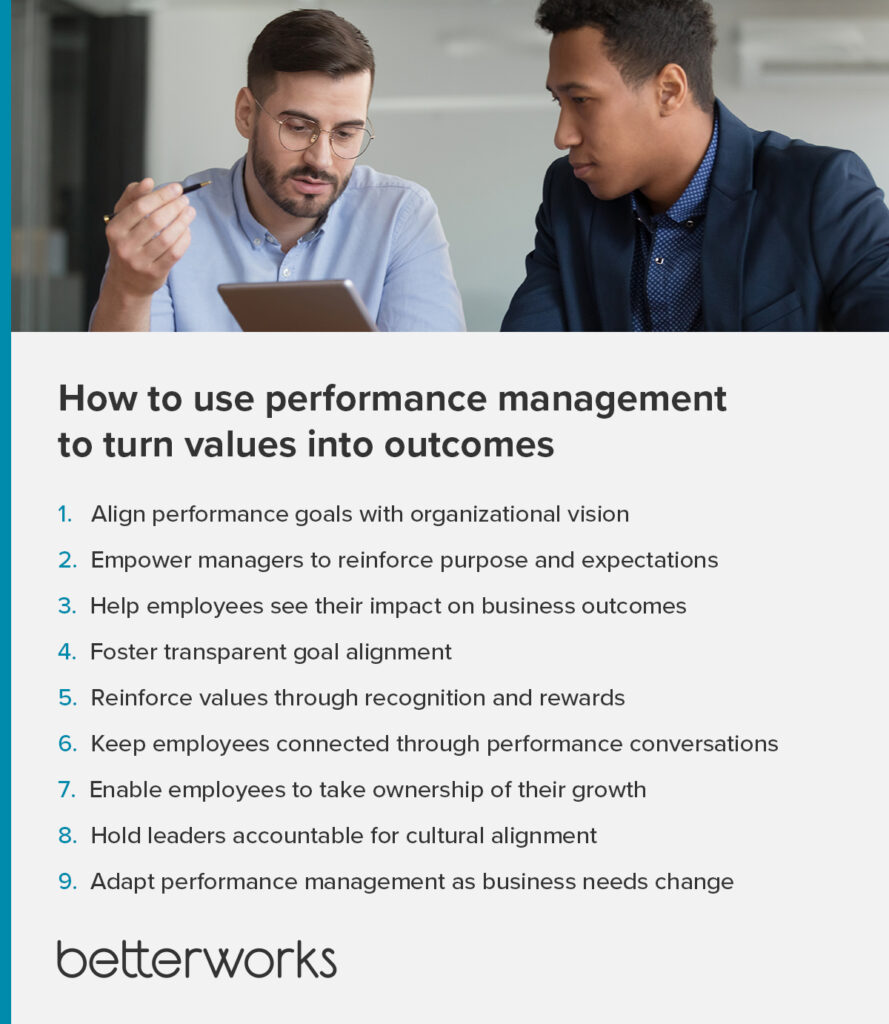If your company values don’t show up in performance management, do they even matter? Employees follow what’s rewarded and measured. Knowing how to align employees with company goals and values is the difference between a culture that thrives and one that fades into the background. If values aren’t tied to goal-setting, feedback, and recognition, they’re just empty words on your website.
This disconnect isn’t just theoretical—it has real-world consequences. Purpose is one of five key dimensions employees need to thrive at work, according to Mercer’s 2024 Global Trends Report. When employees don’t see how their daily work aligns with company values, engagement suffers.
Without a structured approach to reinforcing values through performance management, you risk not only disengagement but also talent loss. But when employee goals align with your company’s goals, vision, and values, your workforce gains a sense of purpose that fuels both short-term performance and long-term retention.
Discover how performance management aligns goals and values to drive measurable outcomes.
How are mission, vision, values, and goals connected?
A strong foundation of company values and mission helps employees stay aligned with business objectives and feel connected to their work. But for these guiding principles to drive real impact, employees need to understand how they align with the company and how they translate into daily actions.
Mission: What you need to do
Your company’s mission defines its purpose—what it sets out to achieve every day. It serves as a guiding principle for employees, helping them understand where to focus their efforts and how their work contributes to broader organizational goals.
For example, if a company’s mission is to deliver secure, scalable cloud storage solutions, how should an engineer interpret that? Should they focus on strengthening security measures or prioritizing a seamless user experience for customers? Without clear alignment between an organization’s mission and its employees, decision-making becomes fragmented.
When employee goals align with the mission, team members make strategic decisions that move the company forward with purpose.
Vision: Where you want to go
The company’s vision represents its long-term aspiration—the future state your organization is working toward. But a compelling vision only matters if employees understand how their work helps make it a reality.
For example, if a food delivery service has a vision to make healthy eating effortless for everyone, what does that mean for its product managers? Should they focus on expanding meal options, simplifying ordering, or ensuring sustainable sourcing? Without clear direction, employees struggle to prioritize their efforts effectively.
Performance management ensures that employees don’t just hear the vision—they actively align with the company’s long-term strategy through measurable goals and actions.
Values: What you believe in
Your company values are the principles that guide how work gets done. They shape company culture, influence decision-making, and create consistency across teams. But values only have meaning when they are reinforced in daily work.
For example, if collaboration is a core value, does that mean employees should always prioritize teamwork over individual tasks? Or does it mean setting personal deadlines that ensure colleagues receive deliverables on time? Using values to set goals provides employees with clarity, ensuring they understand how to apply values in practice.
When embedded into performance management, values become more than an aspirational statement — they become the foundation of an aligned company culture where employees feel engaged and empowered.
Goals: How you get there
While values provide the framework, employee goals turn strategy into action. Goals align individual and team objectives with the company’s broader vision, helping employees stay focused on both short-term execution and long-term growth.
For example, if a security company’s mission is to make home security accessible to everyone, a product team might set a goal to launch an affordable smart security camera within 12 months. This aligns the team while reinforcing the company’s commitment to accessibility.
Linking company values to goals encourages employees to make decisions that reflect both company objectives and strategic priorities.

How to use performance management to turn values into outcomes
A strong performance management system guarantees that your company values and mission aren’t just statements but guiding principles that drive team alignment and measurable success. Integrate values into goal-setting, coaching, and feedback to help employees see how their work contributes to organizational goals and feel connected to the company’s vision.
Performance management gives you the tools to align employees with company goals and create a culture of accountability, engagement, and continuous improvement.
Align performance goals with organizational vision
Your company’s values provide the foundation for decision-making, and goals turn vision into action. But values need to be more than words—they should guide the way employees work every day. Performance management helps you set clear, structured objectives that help employees stay focused on what matters most.
When employee goals align with company objectives, employees understand their priorities and contribute meaningfully. If innovation is a core value, for example, goals could encourage employees to take calculated risks and propose new ideas that drive business success.
Empower managers to reinforce purpose and expectations
Managers are responsible for helping employees see how their work supports the company’s mission. When managers align employees with strategic priorities, they create a sense of purpose that increases engagement and performance.
Performance management gives managers the tools to set clear expectations, provide ongoing feedback, and recognize employees for demonstrating core values. With structured check-ins, coaching conversations, and values-driven goal-setting, managers keep employees connected to the company’s vision.
Help employees see their impact on business outcomes
Employees are most engaged when they understand how their work contributes to company objectives. If a company prioritizes sustainability, for instance, an employee in operations should be able to track how their process improvements contribute to waste reduction goals, reinforcing alignment with the company’s mission.
Performance management software allows employees to track their progress and understand how their work moves the business forward. When employees can visualize their impact, they feel more engaged and motivated to meet both short-term and long-term objectives.
Foster transparent goal alignment
Employees need a clear understanding of how their work fits into the larger company structure. Performance management promotes transparency by mapping company objectives and showing how individual and team goals connect with each other and contribute to success. Goal alignment software makes these connections visible, ensuring team alignment and strengthening leadership accountability across the organization.
Reinforce values through recognition and rewards
Employees need to be recognized for demonstrating company values, not just for hitting performance metrics. Aligning compensation to company culture reinforces what matters most to your organization.
Performance management helps link recognition directly to values-driven behaviors. If collaboration is a core value, for example, reward employees who excel in teamwork and cross-functional success. Public recognition and structured incentives help reinforce company culture in meaningful ways.
Keep employees connected through performance conversations
Values-driven performance management goes beyond annual reviews. Regular conversations about performance help employees stay engaged and aligned with evolving company priorities. Structured check-ins help employees navigate change and understand shifting business objectives. Continuous performance management creates an ongoing dialogue that keeps employees motivated, focused, and aligned with the company’s mission.
Enable employees to take ownership of their growth
Actively engaged employees are more likely to take greater ownership of their development. When employees see a clear path for growth, they stay engaged and committed to long-term success. Performance management gives them the clarity to set personal development goals that align with the company’s mission. By tracking progress and receiving ongoing feedback, employees can identify skill gaps and career opportunities.
Hold leaders accountable for cultural alignment
Leaders set the tone for company culture, and performance management holds them accountable for ensuring alignment between an organization’s mission and its employees. Tracking leadership accountability through engagement surveys and feedback loops ensures executives reinforce values in their decision-making, driving real cultural alignment.
Adapt performance management as business needs change
Performance management must evolve alongside your business. A flexible system keeps company values at the forefront as strategies shift. Regularly reviewing performance data helps identify misalignments and course-correct goals as needed. When employees receive ongoing coaching, they stay adaptable and focused on both short-term and long-term priorities.
Companies that integrate continuous feedback into performance management create a culture of agility and resilience while staying rooted in their mission.

AI’s role in goal alignment and workforce engagement
AI is transforming performance management by improving how goals align with business priorities and values. AI-powered tools, like Betterworks, can analyze performance data to suggest personalized, values-driven goals, ensuring that employees stay focused on what matters most.
Research from Betterworks’ 2025 State of Performance Enablement report reinforces AI’s impact on goal alignment. With 90% of AI users reporting greater goal efficiency, AI shows great potential in helping managers refine objectives and track progress in real time. Furthermore, employees who use goal software report 3x greater alignment and satisfaction than those without, underscoring the importance of structured, data-driven goal management.
Take values from aspirational to actionable
If values aren’t part of performance conversations, they become aspirational ideals rather than guiding principles. A structured performance management system ensures that employees are aligned with company goals and values, giving them a clear sense of purpose and direction. By integrating values into every stage of the performance cycle, you create a culture where employees not only understand what the company stands for but actively contribute to it.
The companies that succeed are the ones that make values more than a statement—they make them a measurable part of how work gets done.
Employees with goal software report 3x greater alignment than those without









